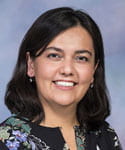Nine faculty received the 2021 George R. Brown Award for Superior Teaching, which honors top Rice instructors as determined by the votes of alumni who graduated within the past two, three and five years.
The winners of this year’s awards are being honored during an unprecedented time at the university. We asked the recipients for their thoughts on what they’ve learned teaching amid the COVID-19 pandemic.
Philip Ernst, associate professor of statistics
It is both an honor and a privilege to be an educator. I believe that imparting students with a deep appreciation for statistics and probability is a responsibility I have not only to my field, but to the academic community at large. The shift to Zoom classes has made this mission much more difficult to achieve. Indeed, the COVID-19 pandemic has taught me just how essential face-to-face instruction is for the overall student experience. There is truly so much more that we can accomplish together in person.
Betul Orcan-Ekmekci, assistant teaching professor of mathematics
Teaching amid the COVID-19 pandemic is challenging, but I appreciate the resilience and motivation of each member of our university and our community. I am very proud of it! I also realized how precious our in-class interaction is. We adapted well to the online environment. We created various amazing asynchronous learning tools for our students during this time. Now, we can utilize these tools in the coming semesters.
Bilal Ghosn, lecturer in bioengineering
The COVID-19 pandemic has altered our approach to education dramatically. In particular, my laboratory courses were more greatly affected than my lecture courses in this case. While Zoom sessions were useful to keep some interactive nature in the courses and provide presentation and discussion opportunities, there is really no way to fully replicate the hands-on experience students receive with an in-person setting. With that said, we have learned that while not a full replacement for course materials and exercises, that creating virtual opportunities for our students is plausible, and can serve as tools for reinforcement once we hopefully return to true in-person learning.
Lesa Tran Lu, lecturer in chemistry
This year has really shown just how creative, resourceful and resilient the Rice community can be. Regardless of the means of instruction, it is through meaningful relationships that we can collaborate and support one another to foster the most effective learning environments. But I cannot wait to see my students back in the classroom again!
Reto Geiser, associate professor of architecture
The past year has undoubtedly been challenging for students, faculty and administrators alike, and while everyone has made a huge effort to adapt their teaching to a remote delivery, we were all reconfirmed in our belief that a direct and immediate exchange in the classroom cannot be replicated in virtual space. This is particularly evident in artistic, design-based courses and seminars with applied, hands-on components that combine critical thinking with making. The design studio is an incubator for ideas, an environment in which students not only learn from their instructors, but equally also from each other, outside of class. But despite all the aspects of in-person teaching I sorely miss, the inevitable asynchronous delivery of my lecture course has encouraged me to reconsider the structure of my teaching, and to use my time with the students more productively by completely flipping the classroom and encouraging active engagement with the course material. While I look very much forward to engaging students in person again — to be exposed to their amazing energy and intellectual curiosity — some of the insights gained in this unsolicited experiment of the past year will continue to influence my work as an educator, and remind me that change always brings opportunity.
Amelie Carlton, lecturer in economics
Teaching amid the COVID-19 pandemic has taught me that it is important for all of us to appreciate the efforts of students, faculty and staff. Their dedication to the Rice community enabled us to succeed in these difficult times. I am so grateful for the culture of care at Rice, and I am committed to continuous improvement as a member of this community.
Burke Nixon, lecturer in program for writing and communication
Teaching via Zoom has taught me the importance of the mute button: I’m learning how to be silent more often during discussions, taking notes about what my students are saying, rather than the other way around. On a bigger level, teaching during a pandemic has reminded me that we can’t be so focused on our learning goals that we forget to pay attention to our students as human beings. Being a college student isn’t easy, and especially not right now.
Marcia Brennan, professor of religion and art history
The COVID-19 pandemic has underscored the importance of presence. During this challenging year, we no longer met one another’s gaze directly in the classroom. Instead, we engaged each other through the multiple windowpanes of Zoom technology. We quickly came to appreciate the ways in which our computer screens are at once windows, filters, barriers and lifelines. So many times, we discussed questions of authenticity and reproduction, of resiliency and vulnerability, while considering how we navigate the unknown. With Zoom, a person can be as close as a block (or even, just a room) away, yet they still cannot be seen or touched directly. Key questions arose concerning proximity and distance, intimacy and isolation, as well as the need to rethink beginnings and endings, hellos and goodbyes. Just as we focused on issues of identity and communication, we considered how each of us defines topics such as acceptable risk, how we allocate resources, and how we value life itself on both the individual and collective levels. These experiences made us question whether access to technology is a new human right. Everyone agreed on the need for a moving humanism when facing such practical and ethical complications. Ultimately, this experience shed great light on the gift of presence in an age of social distancing.
Rafael Verduzco, associate professor of chemical and biomolecular engineering
First, I’ve been reminded about the dedication of our students. At the start of teaching via Zoom when all of my lectures were available live and recorded, I worried students would tune out, not participate, or maybe just watch the recorded lectures on their own time and not come to the live class sessions. In reality, I found this rarely happened and was pleasantly surprised by the interest and commitment students showed to coming to class, learning and making the best of a difficult situation. We are lucky to be at Rice with such dedicated and enthusiastic students.
Second, I’ve learned about a variety of tools for effective online teaching. The use of Zoom with breakout rooms, chat functionality and accessibility to online content makes it easy to share materials and create a dynamic and engaging online class. It is also easy to schedule virtual office hours and meet and talk to students at times that would have otherwise been inconvenient or impossible. There is definitely a lot we lose from not having in-person classes, but many things are actually easier online, and in the future I hope we continue to take advantage of some of these online resources as we transition back to in-class lectures and in-person learning.










